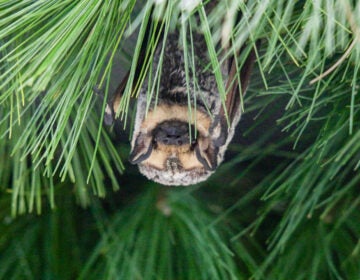Beware of the belching black hole
ListenChandra X-Ray satellite observes enormous eruption from our Milky Way Galaxy’s black hole . This extreme outburst could be due to a close-passing asteroid being torn apart or magnetic field lines reconfigured and recombining. Astronomers refine their ability to determine the age of a star. China Moving Up! In Space! – Now has a spacecraft orbiting the moon in addition to the lander that’s now roving the surface
January 19, 2015
[Dave Heller] The black hole at the center of our Milky Way galaxy is flexing its mighty muscle. Prepare to be shocked and awed with Derrick Pitts, chief astronomer at the Franklin Institute. Derrick, black holes swallow everything in their path — turns out they can also regurgitate the leftovers.
[Derrick Pitts] Oh yes indeed they do that on a fairly regular basis. In fact any kind of material that heads toward the accretion disk of a black hole of a singularity eventually gets broken down into its constituent components anyway. And very often a lot of that material is blasted out.
But we’re talking about a really big blast in this case.
In fact we’re talking about several really enormous blasts recently identified or seen by the Chandra X-Ray satellite. One of those blasts, and the most recent one in October of last year was 200 times the normal output of x-ray energy, typically observed at supermassive black holes of this type. But there’s one back in September of 2013 that was 400 times the normal amount of energy blown out by black holes of this type.
And for what duration is that uptick observed? Just for an instant, or for years?
Actually it’s somewhere in between. It’s long enough to be observed by a satellite but certainly not years-long. These blasts can probably take several hours to develop and to their full intensity and then begin to dissipate again, so you know, less than a day probably is the length of time.
What causes the indigestion?
Well it’s really difficult to say. There are two possibilities in this particular case. One is, perhaps, an asteroid passing close to the supermassive black hole located at the core of our galaxy was broken apart by the tidal forces created by this enormous object. And as the pieces crashed down onto the accretion disk, the acceleration of those pieces crashing onto the disk would cause explosions that would generate x-rays.
Little bitty pieces of an asteroid can cause such tumult?
Yes, one always has to remember that in the case of a black hole, any object approaching the black hole is accelerated to really high speeds. So even if you take something with a very small mass, if you accelerate it to a very high speed, it will exert a tremendous amount of force. And in this case, the force that’s generated helps to convert the material out in to x-rays anyways. So that’s how x-ray bursts like this could possibly be seen. There’s one possibility for how an enormous x-ray burst like this could be see. Another possibility is that the strong magnetic field surrounding the black hole could have had some effect on this. In that, magnetic field lines generated around the black hold could have somehow become tangled up, and then in their reconfiguration or reorientation to a more normal state, generated this enormous burst of energy that was seen. So astronomers are not really sure yet which of these it is yet but there are two good possibilities for what could happen.
Our sun goes through a cycle some eleven years long where the energy levels vary and there are solar flares and ejecta, with it come cautions for here on Earth. Is there any danger of a black hole at the center of our Milky Way causing disruptions on terra firma?
If we were closer, yes. There could be serious problems. But fortunately, we’re a very, very good distance away. This is at the center of our galaxy — we’re two-thirds the distance out from the center — so there being some 30, 35,000 light years away from the center of the galaxy really helps us. So fortunately at this distance, it’s still far enough away that we don’t really have to be very concerned about the normal, operational output of this supermassive black hole.
More observational prowess, astronomers are doing a better job of dating stars, and they’re not doing it with match.com.
[Laughs] Nor are they counting rings at the core of the stars like we might do with trees to figure out. But it’s actually not too far off. Actually what astronomers are doing is they are measuring the rate at which stars rotate, comparing that to the mass of the star, and using that as a way to derive a true age for the star. And in fact they’re doing very, very well with this method that has recently been identified as something that can give an age to within 10% of the actual age of the star. That’s pretty good.
How old is our star?
Our star is about 5 billion years old, our solar system about 4.5 billion years old.
With that, is our sun a relative newbie, middle-aged, or on the way out?
It’s neither in its infancy nor in its senior citizen years — it’s right in the middle of the main part of its life. So everything’s going just fine. It looks like every other star that’s just like this star at this age in its life. But if we just change the mass of the star we can find that things can shift around dramatically. So, for example, stars that have much, much more mass than our star live much shorter lives. So to be 5 billion years old and be near the end of life for a star that’s much more massive. For stars that are way less massive than our star is, this could be the very infancy of those very, very low mass stars. So it all depends on what type of star it is, how much mass its life begins with that will determine A) how long its life is and where in its life cycle this particular 5 billion years of age we have for our star would fall in its life cycle.
And so stepping out of doors, looking at the heavens above, are most stars around the same age as ours? Older, younger?
There’s a distribution of various ages around us, but if we look at the stars across the galaxy itself, we find out that the most numerous stars are the low mass stars. And that’s something that’s been identified only quite recently. And the reason why is because their luminosity is so low that we haven’t been able to detect them before. In fact, they don’t even generate enough heat that we can see them visually as bright stars. But we have to use other methods, we have to use infrared detectors that only sense heat and don’t sense light to be able to identify them. So in a sense, they’re only warm enough that they glow in the infrared portion of the spectrum. So you wouldn’t see them, but if you were close to them you’d feel their heat. So there are many, many more stars like that in our galaxy than any other type. They actually make up the greatest population of stars in our galaxy.
They’re built for comfort, not for speed.
Ah, exactly. And because of that, they live a very, very, very long life.
Hey, move over NASA — China’s making great strides in its space exploration efforts.
You know, and very deliberately too. They have plans going forward to try to get someone up to the moon probably by the early 2020’s. And in an effort to try to make that all happen, they’re concentrating their efforts on building blocks necessary, or steps necessary, to have a successful visit to the moon. So, not only do they have a rover on the surface of the moon right now that seems to be working fairly well, they’ve also orbited a service module of another spacecraft that launched on October 24. So just having reached lunar orbit, it’s doing very well in orbit. All the systems on board are working according to plan as is being reported so far. We don’t know how long the orbit is going to be there, but there’s some thought that cameras on board the orbiter are photographing the surface, looking for a suitable landing spot for their next step in their efforts to get to the moon. A lander that would grab samples of lunar material to bring back to Earth, that’ll be known as the Chong-E-5 mission.
In China’s case, is it all homegrown effort and technology, or are they working in concert in Europe and/or Russia and/or United States?
Yeah, that’s a really interesting question. And in that while we do have some agreements with China about space exploration, they are essentially working on their own by themselves intentionally.
WHYY is your source for fact-based, in-depth journalism and information. As a nonprofit organization, we rely on financial support from readers like you. Please give today.




